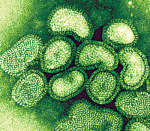by
Heather Mayer, DOTmed News Reporter | June 25, 2010

H1N1 detection test approved
The U.S. Food and Drug Administration (FDA) approved a test developed by the Centers for Disease Control and Prevention (CDC) that will diagnose human infections with the H1N1 influenza virus, which was a pandemic in 2009 and early 2010.
The test will allow for quick laboratory confirmation of whether the virus is present, enabling health care providers to determine proper treatment, says Dr. Michael Shaw, associate director for lab science in the influenza division of the CDC.
The test, called CDC Influenza 2009 A (H1N1)pdm Real-Time RT-PCR Panel (IVD), was approved under emergency authorization during the recent pandemic, a provision under special situations for public health emergencies. But now, the test has been given FDA 510(k) premarket approval, Shaw tells DOTmed News.
Unlike the earlier version of the H1N1 diagnostic test, this one is able to more sensitively detect the subtype H1N1. The earlier test was developed based on a limited number of H1N1 specimens available in April 2009, when the pandemic began. Now the test can detect human infections with sensitivity and specificity greater than 96 percent for upper respiratory specimens, according to the CDC. The new test will still include universal swine flu, says Shaw, because periodically there are outbreaks of swine viruses infecting humans.
In order to detect H1N1, which the seasonal flu test cannot do, primers -- small pieces of nucleic acid -- will bind to any existing H1N1 nucleic acid. A full copy of the nucleic acid is made if H1N1 is present.
The test is currently being sent out to CDC-qualified laboratories for detecting 2009 H1N1 influenza, the same strand that will be included in the new seasonal vaccine, says Shaw.
